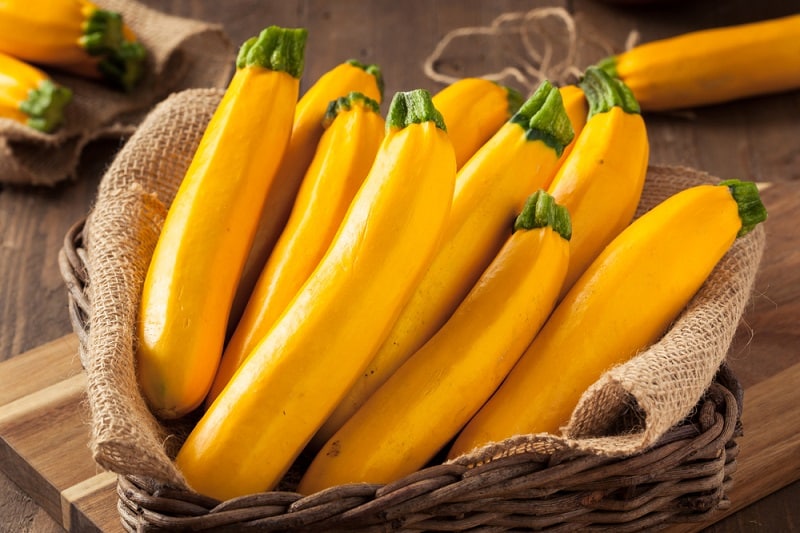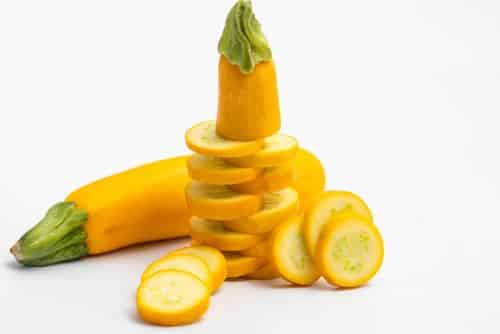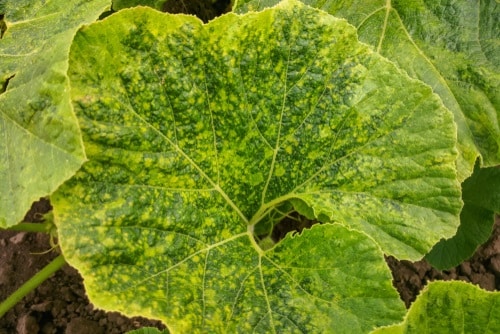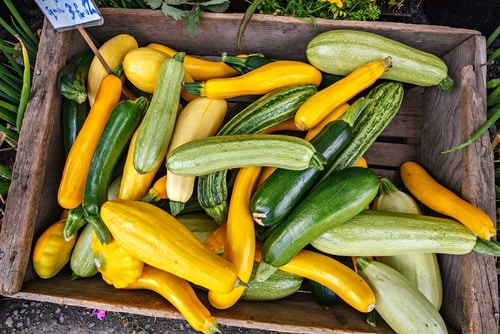
About Yellow Squash
Yellow squash doesn’t seem to be as well-known or as popular as its close relatives, zucchini. They’re basically the same, except that yellow summer squash has beautiful golden skin while zucchini is dark green. They are both usually white or creamy white on the inside, but sometimes this goes wrong.
If you haven’t tried this delicious summer squash before, please give it a chance. You might find two types of yellow squash in your fresh produce section – one that is straight and another that has a curved neck. The skin should be thin and soft.
They’re Nutritious!
Whether you eat yellow squash raw or cooked, they are nutritious, delicious, low-calorie, and low-carb. Try them steamed, roasted, or even sliced into strips for an Asian stir-fry. Some people spiralize them to make vegetable noodles. They have a mild flavor, so they work with many different herbs, spices, and sauces.
Why Is Your Yellow Squash Green Inside?

Yellow squash is one of the prettiest vegetables around, with its bright yellow skin and creamy interior. However, sometimes a yellow squash may come with a slightly green interior instead of the normal white one. There may be green patches on the skin too.
According to scientific research, a yellow squash gets a green interior due to a notorious plant virus called the Cucumber Mosaic Virus (CMV). CMV is a virus first diagnosed inside a cucumber in 1934. The said cucumber had a pale bumpy exterior instead of the bright green one.
It has been shown that despite its name, the Cucumber Mosaic Virus infects a large variety of things, including vegetables like beets, spinach, celery, lettuce, tomatoes, beans, peppers, carrots, and melons.
The Cucumber Mosaic Virus is commonly spread by tiny sap-sucking insects called aphids. Although these can be prevented by spraying the plants with insecticides, there are no other solutions to delay the spread of the virus or salvage the produce once infected.
Fortunately, a virus-infected yellow squash is not harmful in any way. When eaten, it will taste like a cucumber, which is quite fitting for having a cucumber-like interior. As a result, farmers usually grow yellow squash with a precocious yellow gene because a squash with the precocious yellow gene masks the green color with its strong yellow color.
Effects and Remedies

Even though the Cucumber Mosaic Virus is not harmful to the human body, the virus is still a plant-killing problem that decreases the seasonal production of yellow squash by a fair amount.
Also, scientists have not developed a chemical that reduces the spread or outright eliminates the virus. As a result, it is up to the farmers to take care of their yellow squashes by keeping them from getting infected with the Cucumber Mosaic Virus in the first place by eliminating aphids as much as possible.
There are a few precautions that you can take when growing yellow squash in your home garden that will prevent the Cucumber Mosaic Virus from spreading. Some of these precautions are listed below:
- Always buy virus-free yellow squash seeds, plants, and the vegetable itself.
- Create and maintain a strict aphid control system.
- You must remove every trace of weeds from the growing space because weeds are common carriers of the Cucumber Mosaic Virus and aphids.
- If you find one of your yellow squash infected with the Cucumber Mosaic Virus, look for other infected vegetables and remove them from the ground.
- Do not throw infected plants onto the compost pile but rather burn them.
- Disinfect your tools after removing virus-infected plants.
- Use seeds to propagate yellow squash rather than seedlings that might have been infected in the nursery.

To Conclude
Please do not let your newfound knowledge of this virus put you off trying this delicious vegetable.